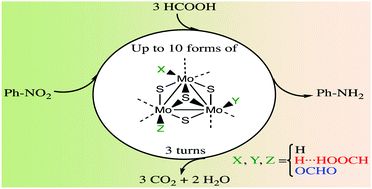On the catalytic transfer hydrogenation of nitroarenes by a cubane-type Mo3S4 cluster hydride: disentangling the nature of the reaction mechanism†‡
Abstract
Cubane-type Mo3S4 cluster hydrides decorated with phosphine ligands are active catalysts for the transfer hydrogenation of nitroarenes to aniline derivatives in the presence of formic acid (HCOOH) and triethylamine (Et3N). The process is highly selective and most of the cluster species involved in the catalytic cycle have been identified through reaction monitoring. Formation of a dihydrogen cluster intermediate has also been postulated based on previous kinetic and theoretical studies. However, the different steps involved in the transfer hydrogenation from the cluster to the nitroarene to finally produce aniline remain unclear. Herein, we report an in-depth computational investigation into this mechanism. Et3N reduces the activation barrier associated with the formation of Mo–H⋯HOOCH dihydrogen species. The global catalytic process is highly exergonic and occurs in three consecutive steps with nitrosobenzene and N-phenylhydroxylamine as reaction intermediates. Our computational findings explain how hydrogen is transferred from these Mo–H⋯HOOCH dihydrogen adducts to nitrobenzene with the concomitant formation of nitrosobenzene and the formate substituted cluster. Then, a β-hydride elimination reaction accompanied by CO2 release regenerates the cluster hydride. Two additional steps are needed for hydrogen transfer from the dihydrogen cluster to nitrosobenzene and N-phenylhydroxylamine to finally produce aniline. Our results show that the three metal centres in the Mo3S4 unit act independently, so the cluster can exist in up to ten different forms that are capable of opening a wide range of reaction paths. This behaviour reveals the outstanding catalytic possibilities of this kind of cluster complexes, which work as highly efficient catalytic machines.



 Please wait while we load your content...
Please wait while we load your content...